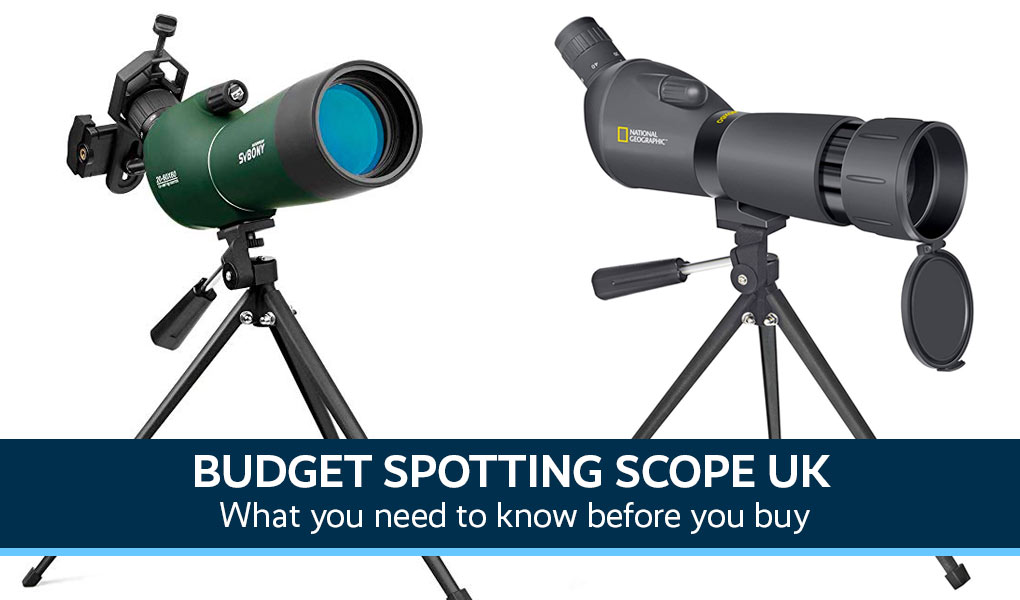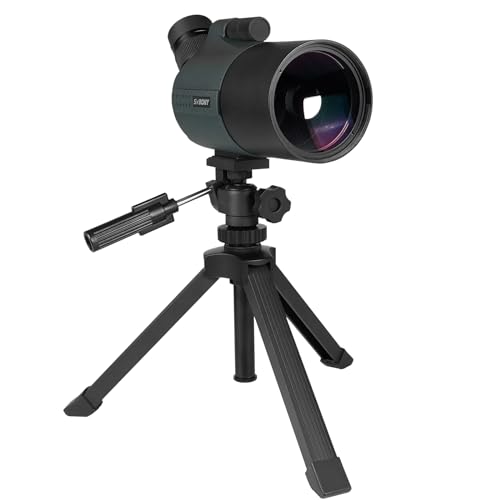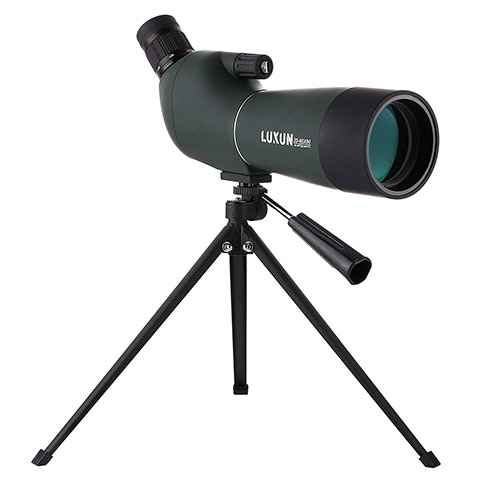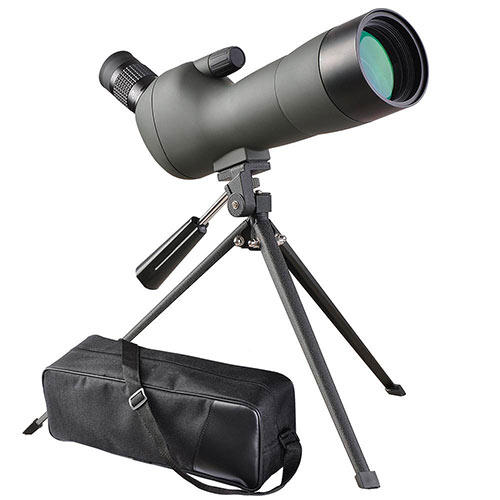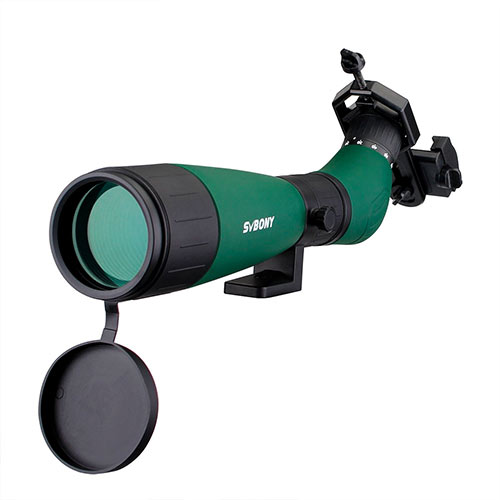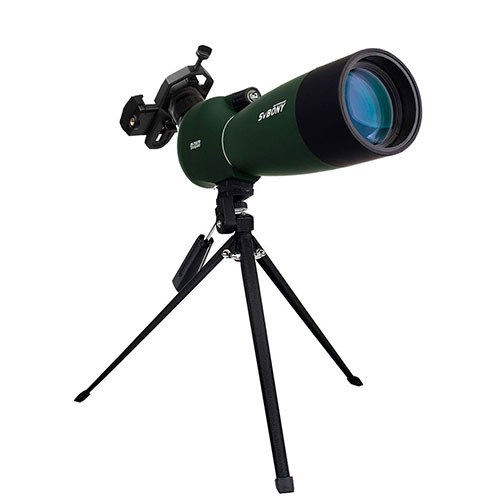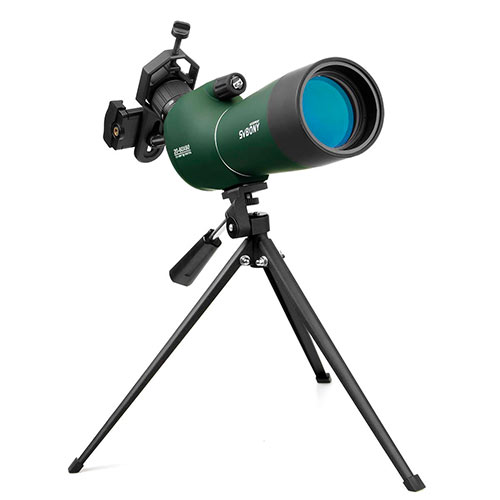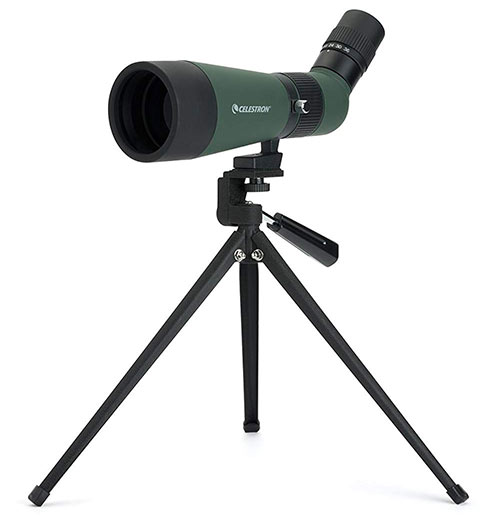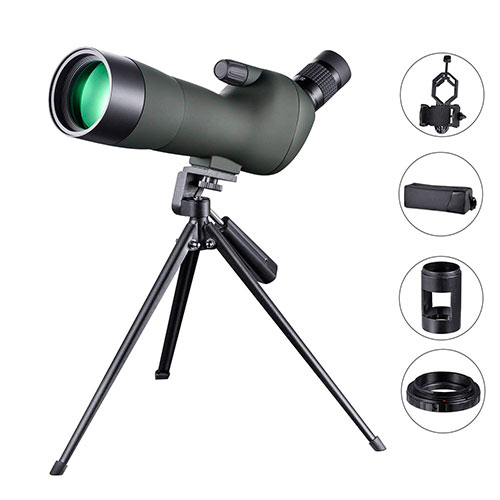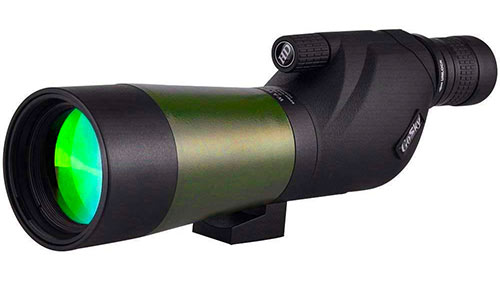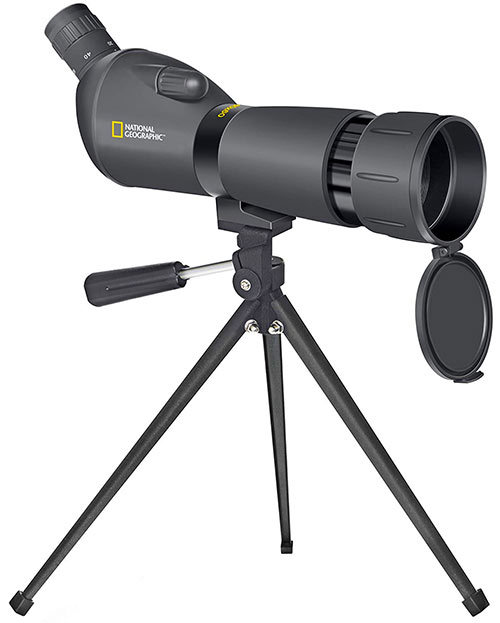Are you interested in birding or watching any other wildlife, a keen hunter, looking to carry out surveillance or do you just need to see objects in the distance closer? You’ve come to the right place, as in the following guide we are looking at good budget spotting scopes. Normally, as you may know, spotting scopes are available for a hefty investment. Especially if you want a super, tricked out model with lots of extra features and powerful magnification specifications.
However, as the technology behind them has move along dramatically, the lower end of the price range features products that are not just cheap imitations of the higher priced options. These are highly effective and quality spotting scopes that are made for those with smaller budgets.
The world of low-priced spotting scopes can be a tough one to navigate, as there are lots of tempting offers tat may sucker you in, if you’re not sure what you should be looking for. That’s where we enter, by providing the following guide, with reviews of the best affordable spotting scopes, alongside our insightful buyer’s guide that looks at things you to consider when buying one of these accessories that won’t break the back. As well as some of the features that are important too.
We hope you spot (we’re not going to apologise for that pun) a great bargain while reading this guide and find the best budget spotting scope for you.
Table of Contents
Best Budget Spotting Scope UK 2019
1. LU2000 Angled Zoom Spotting Scope
The first budget spotting scope we want to discuss is this angled scope beauty from LU2000. This has magnification power of up to 60x and has a generously large objected lens with a diameter of 60mm. So not only can it help you to have a clear image of things a fair distance away, it enables a high amount of light transmission to take place to provide clearer and brighter images.
As an angled scope, it’s set to 45-degrees, to reduce the amount of fatigue you would suffer from using it. Thanks to the nitrogen-purged, fog proof and waterproof construction of the lens, you can use it in just about any weather. The lens features a BAK-4 prism for crisp, clear and bright images.
In addition to all the above, fatigue can be reduced and any other issues with visibility and steadiness with the included tripod. Considering its relatively low price, this offers a great amount of all-weather, all-application versatility.
2. ReaseJoy 20-60×60 Spotting Scope
Next up, we’ve got the ReaseJoy spotting scope with a variable magnification of 20x to 60x and a lens that meets the standard that most companies aim for of 60mm. These features allow the scope to focus and zoom in on targets at distances with great results. To protect the scope in various weather conditions, it’s built with a rubberized and nitrogen-flooded housing that provides anti-slide protection along with fog and waterproofing.
The lens is coated with a special green film that brightens the image and makes it even clearer. It can also help to reduce the amount of eye fatigue you may experience with prolonged use. With the viewfinder angled at 45-degrees this is also a lot easier to use and won’t cause fatigue or discomfort, even if you spend a considerable amount of time looking through it
3. Svbony SV18 20-60×60 Angled Spotting Scope
For a slightly higher price than the two other spotting scopes we’ve featured so far, you can get this Svbony angled spotting scope. The SV18 also benefits from a magnification power of 20 to 60x and has an objective lens 60mm. Where this is slightly better I the BK-7 prism and fully coated optics it features for better transmission of light to make clearer and brighter images. As if that wasn’t enough, it also features a sunshade that can be extended to help reduce glare and protect the effective lens from scratches and scrapes.
Similarly, to the others we’ve featured so far, this has an angled design with an eyecup that can be twisted upwards or downwards when you need to quickly change the position, you’re holding it.
With its rubberised armoured construction and nitrogen-filled housing, this is designed to cope with all weather conditions and will cope with any bumps and bangs. This also has a standout feature in the form of an adaptor that means you can hook your phone up to the scope and save images and videos of things at a distance. Once you’ve taken them, you can then upload them to the net and share them through social media.
4. Svbony SV28 25-75x70mm Spotting Scope
Sticking with Svbony for the next item in our guide, we’ve got the SV28 model. This model features, in a departure from the scopes we’ve featured thus far, a magnification power of 25 to 75x and an objective lens with a diameter of 70mm, making it slightly higher performance and better able to provide brighter and clearer images. It utilises multi-coated green film and BAK-4 porro prism to help improve the clarity of your experience, even when you’re using it in lower light.
Compared to others, this has been waterproofed to IP65 rating and features O-ring sealing that protects it against debris and dust, and all forms of moisture. While the nitrogen-flooded housing prevents fogging from occurring. As well as a tripod, this model, like the one above, also features the digiscoping adaptor that means you can transform your phone into an even more powerful camcorder or camera and take images and videos at distances with excellent brightness and crispness.
5. Svbony SV28 20-60x60mm Spotting Scope with IP65 Waterproof
Yet another great budget spotting scope from Svbony, this has a lot in common with the other models above. For one thing it has the same magnification power as the first, but with some of the improved features of the second one. So along with the 20 to 60x magnification power and objective lens with a diameter of 60mm, it benefits from the multi-coated green film and BAK-4 porro prism optics for bright, high contrast and clear images
It also has the same IP65 waterproofing rating as the above thanks to the same construction quality and 0-ring sealed housing. This provides protection against all debris, dust, dirt and water. While the nitrogen-filled housing of the lens prevents it from fogging up. Other great features are the table tripod and the digiscoping adaptor that means you can hook it up with your smartphone to improve the quality of your images and video footage.
6. Celestron 52322 12-36×60 Landscout Spotting Scope
One of the bigger names in the industry, Celestron, are responsible for the next spotting scope in our budget-friendly guide. The Landscout has a much smaller magnification power, with a similarly sized objective lens to most in our guide. The lens is also fully coated to give the best sharpness and clarity.
One of the great things about this model tho0ugh is that rather than being stationary and requiring you to use it in virtually the same position all the time, the table-sized tripod included is fully rotational, so you don’t need to crank your neck or position yourself in strange ways to get the desired viewing experience you need.
Another great thing, and possibly one of the reasons why it’s slightly pricier, along with the brand name, is the fact it’s much more portable and compact than the others above. This makes it excellent for travelling with and using when you need to move from one location to another quickly.
7. Yukon Scout 30×50 WA Spotting Scope
From Yukon, we’ve the Yukon Scout spotting scope. This again, does not feature quite as high a magnification power as others we’ve highlighted. It also only has an objective lens of 50mm in diameter. Another thing that sets this apart from others, for better or worse, is that it’s a straight scope and not angled.
It does, however, benefit from a rubberised armour coating around the outside to give it the waterproofing and sturdy look and feel you may be after. This is an incredibly user-friendly scope too, as the body can simply be retracted into itself to reduce its size, adding to the portability and compact nature of the already small design.
8. LAKWAR 20-60×60 Spotting Scope
LAKWAR are the manufacturers behind the next budget spotting scope in our guide. This has magnification power of 20 to 60x and the standard objective lens size of 60mm. Thanks to the inclusion of the tripod and the angled eyepiece, viewing through this beaut is relatively simple and comfortable. BAK-4 porro prism and multi-coated green film is used to improve the quality of the images you’ll experience using it and there’s a retractable sunshade that can help keep glare out of your eyes and the scope.
The scope itself has been built with a durable, rugged and anti-slip and anti-shock rubber housing. As previously discussed with regards to other models, it features a special adaptor that can be used with your smartphone or even your SLR camera to give you the power of the scope when taking photos or recording video footage.
9. Gosky 20-60x60mm Spotting Scope
Another budget-friendly spotting scope from a reputable brand with 20 to 60x magnification power and a 60mm diameter lens, is this model from Gosky. The enhanced optics are similar too with BAK-4 prism and multi-coated film. This all helps to improve the light transmission and features multiple coatings of anti-reflective material that stops there being blurs or too much glaring.
Much like the others, it has been deigned to be fog proof, shockproof and waterproof. The thing we particularly like about it though and that sets it apart from the crowd is the phone adaptor, a this works with both smaller screened phones and newer, larger-screened models. Despite it only having a straight lens, we think this has been made to provide an enjoyable and comfortable experience for the user.
10. National Geographic 20-60x60mm Zoom Spotting Scope
The last on our guide is an affordable, high-quality spotting scope from National Geographic. It features the porro prism designed lens and benefits from the low magnification power that performs reasonably well for the price. We like the compact and lightweight nature of this scope and the rotatable tripod makes it much easier to spot those distant objects so you can get the best view possible, without causing yourself discomfort or fatigue.
The fact the eyepiece is set at 45-degrees also makes it worth your consideration if you value comfort over perhaps a higher magnification power. Although it’s sponsored and branded with the National Geographic name, another key point worth noting about this scope is it’s made by Bresser who are one of the leading names in the industry. Don’t easily dismiss this scope.
Best Budget Spotting Scope UK – Buyer’s Guide
To help you choose which one is best from the available budget spotting scopes out there and to further whittle down our selection above, we wanted to discuss some of the important decisions you need to make when buying a spotting scope.
Angled or Straight
There are two main kinds of spotting scope available right now, angled and straight. Sometimes, manufacturers can be a little misleading with regards to what the differences is between them. Angled scopes are considered to be of higher quality, or at the least more comfortable to use, as they offer you the ability to turn the eyepiece through a number of selection of different angles, meaning you can find the sweet spot position that works best for you.
However, this is not exactly the whole truth, as the biggest difference between both varieties of spotting scope are that angled versions are ideal for making up when objects are very different heights without causing chromatic aberrations, whereas straight scopes are better when you’re aiming to view objects the same height as you.
So even though angled copes are more comfortable to use, its not as crucial in the larger scale of things compared to how they’re with viewing objects at different heights. Straight scopes also are a little bit longer and are less tall, whereas angled models are shorter lengthwise, but taller in height.
Lens and Zoom Size
There are two numbers you’ll find that are used to define all spotting scopes and will be written either as 20-60×80 or 20×80. In both situations the number before the x refers to the number of zooms available with that scope. You’ll find though, that rather than being fixed level zoom scopes, most modern varieties offer a variable zoom, meaning they can produce clear images at various zoom settings. So, for the number stated as being 20-60×80, it has a magnification that ranges from 20 to 60.
The number stated after the x refers to the lens size. This is measured in millimetres and indicated the diameter of the lens. Generally, the larger the lens is, the more light it can gather and the better the result will be.
Mirror and Lens Coatings
In their natural condition, mirrors and lenses are not very good at focusing and reflecting the light. When telescopes were first introduced, they were built incredibly large to accommodate and rectify this problem.
With modern spotting scopes though, the problem is solved using cutting-edge manufacturing methods that make new and more complicated lenses or by simply applying specially formulated coatings directly onto the glass.
The glass on mirrors that have not been treated with any chemicals absorb as much as 96% of all the light they’re exposed to. This is an issue if you want to benefit from a bright and clear final image. When coated with these new chemicals, the glass then absorbs only 20% of the light and maybe even less, producing a final image that’s much brighter.
As not all coatings are made equal, you may find that one company’s coatings are better than another’s.
Weight and Size
The weight and size are things you need to think carefully about. While you may feel you want as big a scope as you can afford, you need to consider how you intend to use the scope. If the activities are going to involve a lot of standing and holding it or you need to stay on the move (if you’re hunting for instance), you’ll want something portable and lightweight.
Features That Are Important
Although they all perform the same job, they’re not made equally. By choosing one based on the following, you’ll have a better chance of securing a good quality one that meets your needs and purposes.
Objective Lens Diameter
As previously mentioned, this is the number after the X stated alongside the magnification power. The objective lens is basically the lens at the front of the spotting scope and the size of its diameter is important because it plays a pivotal role in ensuring enough light can enter and help create an image that’s clear and bright.
Magnification Power – Zoom
Magnification power is the number before the x along with the lens diameter, as we’ve already discussed. This refers to the scope’s ability to zoom while still providing a crisp and clear image. Variable zoom scopes are always going to be better, as they provide a more versatile tool for your outdoor activities.
Tripods
Tripods are a good thing to invest in because you’re only going to be able to achieve a clear image with one. You may find some already come with a tripod whereas others you’ll need to buy one separately.
Not everyone agrees you need them, and it may be easier to get a smaller, but more powerful scope. Needing to fold up a tripod each time you need to move to a new location or spot, could become tiresome quickly.
Conclusion
There we have it, the best budget spotting scopes available right now. There are better models out there than the products we’ve featured. However, when you’re looking for something a little on the cheap side for irregular and non-professional use or if you’re just a beginner, these will serve you well.
